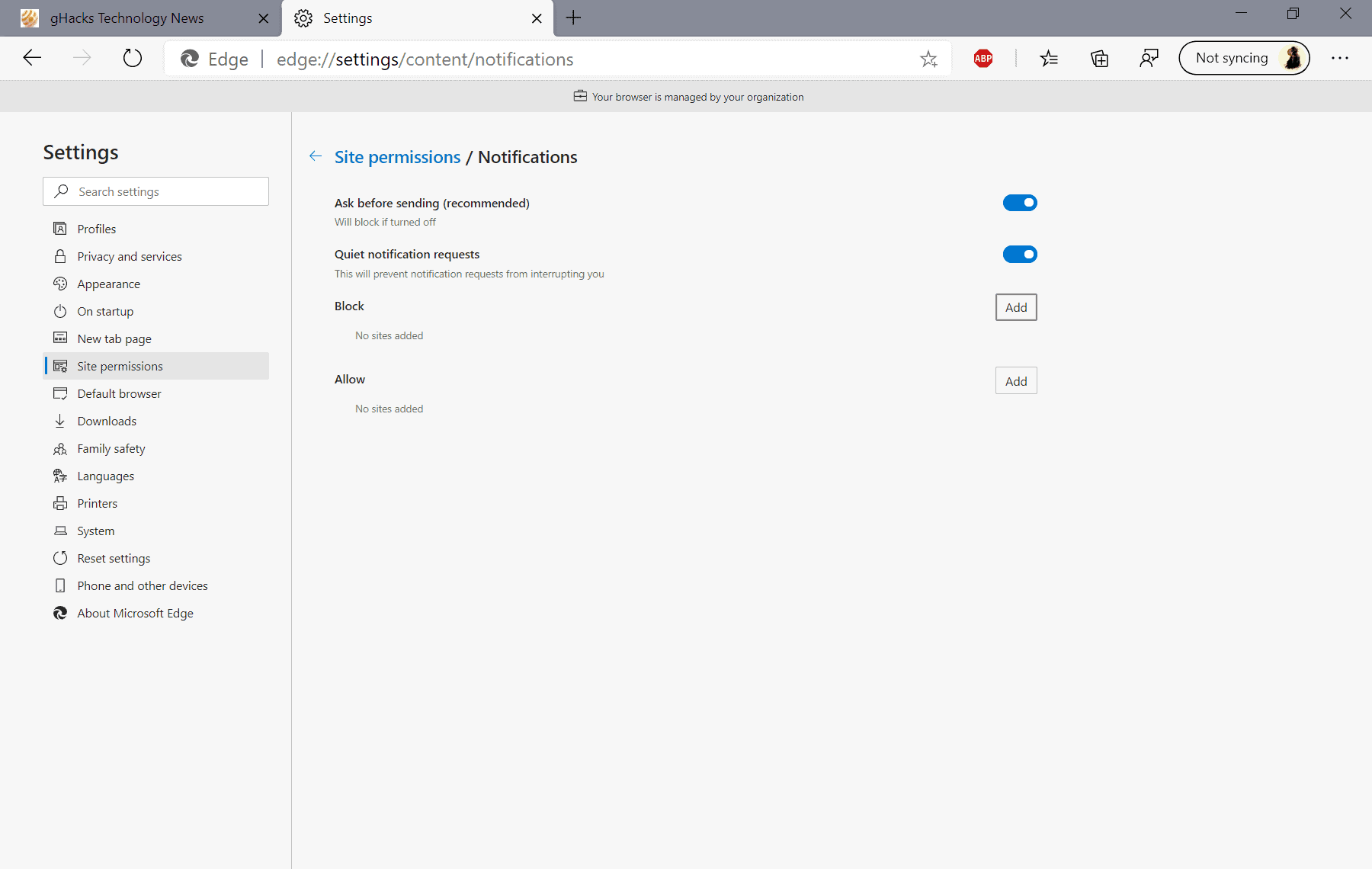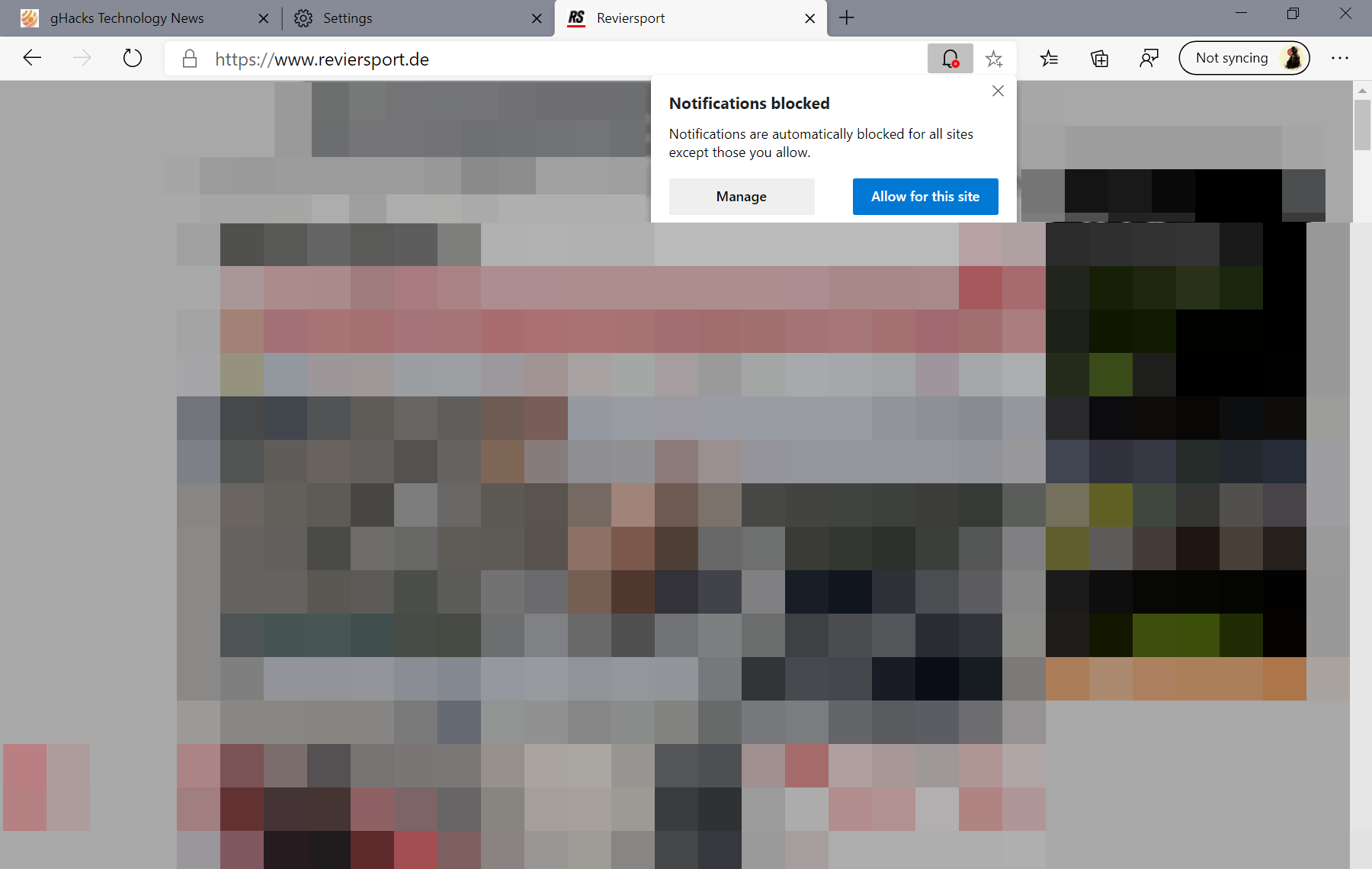A look at Microsoft Edge's new Quiet Notifications system

All modern web browsers support notification APIs that allow sites to push short messages to user devices once the request to accept notifications from that particular site has been accepted by the user.
What has been designed as a way for sites to keep users informed, e.g. of new events, auctions that are running out, new articles or tips, has turned into an Internet-wide overload of notification prompts and notifications; many serve no other purpose than to push advertisement to user systems.
Browser makers started to address issues associated with browser notifications recently. Google introduced quieter notifications in Chrome 80, and Mozilla toned down web notification requests in Firefox 72 as well. The systems have in common that they hide the big request prompts in the browser's user interface when enabled and move it to the browser's address bar instead.
Microsoft added quiet notifications support to its new Microsoft Edge 84 web browser recently as well. The company revealed that it talked to users of its browser to find out more about the real-world use of notifications. It found out that users disliked notification requests, especially when it was not cleared what the site intended to do with the permission and when they did not know anything about the site, but that there were cases in which notifications were used.
Microsoft enabled Quiet notification requests for all users in Microsoft Edge 84, and added an option to the settings to disable the feature. Most users probably want to keep it turned on though as it hides notification prompts on all visited sites in Edge and moves indicators to the Edge toolbar instead.
With quiet requests enabled, site notification requests made via the Notifications or Push APIs will appear as a bell labeled “Notifications blocked†in the address bar, as opposed to the typical full flyout prompt.
Edge displays a bell icon in the address bar when a site tries to get permission for sending notifications to the user device; this is the case even when the request was initiated by the user, e.g. by clicking on a bell icon on the site.

A click or tap on the icon displays the prompt, and it is possible to allow or deny it.
The main effect of moving the requests to the address bar is that users are no longer hammered by requests on the Internet. It is possible to do nothing and not be bothered by notification permission requests.
Managing notifications in Microsoft Edge

Edge users may load edge://settings/content/notifications to manage notifications in the browser. The options allow users to block all notifications in the browser, to manage allow and deny lists, and to turn quiet notifications on or off.
- Ask before sending (recommended) -- Enabled by default to allow sites to push requests for notifications to the user. Disable to turn notifications off.
- Quiet notification requests -- Enabled by default to redirect notification prompts to the address bar to avoid user frustration with prompts. Disable to restore the regular notification prompts.
- Block and Allow -- Useful to block certain sites from ever displaying notifications or to allow certain sites to display notifications.
Closing Words
Depending on your use of the Internet, you may not see that many notification prompts or you may be bombarded by them every day. While there are certainly legitimate uses, most sites that implement notifications use them more for advertisement or outright malicious intents.
Now You: Do you make use of notifications on the Internet?





















I can think of a few things notifications are good for: emails, phone calls, texts and whatever you absolutely have to monitor. Otherwise, not much.
Those who experienced the era of infinitely cascading pop ups probably have little patience for notifications. Spam’s less annoying than most notifications. Some notifications are notifications that notifications are waiting elsewhere. When notifications talk to other notifications with no user involvement, you’ve been hijacked. WTF?!
Indeed. Anything I need to dismiss is a huge nuisance. macOS is now popping these things up frequently so it’s interesting that browser makers are recognizing how bad they are and taking useful steps to minimize the annoyance.
When the websites started this nonsense, I couldn’t believe they imagined I would want a site to notify me through a damn popup.
Remember when they used to be called pop-ups? You see, all you have to do is rename something and it becomes legit.
I really dislike notifications on the internet, especially for ‘news alerts’. I appreciate having them for specific uses like incoming emails or chat, but news alerts should be opt-in instead of opt-out.
“Microsoft revealed that it talked to users of its browser to find out more about the real-world use of notifications.”
Whom did Microsoft talked to if there aren’t any ChrEdge users ?
>Whom did Microsoft talked to if there aren’t any ChrEdge users ?
There are a dozen of us, i tell ya, a dozen of us.
@Jimmy
Did Microsoft consult you regarding the notifications ?
If not, you don’t exist as a ChrEdge user.
I’ve been using ChrEdge since it first leaked. There’s plenty of us around.
@jimmy
First leaked?
Yeah, it leaks. Everything. More like a flood.
No to worry, MS has repeatedly proved they have no idea what to do with all the data they collect; they’re in the data business so they have to collect stuff, I guess.
@ilev
That’s very funny, ha ha ha, because there are Edge users but you treat them as zero. Ha ha. You should become a comedian. LOL. Microsoft is so bad, they have zero users. Ha ha ha!
@ilev
https://thenextweb.com/apps/2020/04/07/microsoft-edge-overtakes-firefox-chrome/
Not saying anyone should use Edge, though. It‘s typical MS spyware.
@Iron Heart
Like anything from Microsoft this is a lie.
As of the end of June 2020 Chrome has surpassed 70% browser market share.
Edge can’t be found.
https://usefyi.com/chrome-history/#:~:text=Google's%20brand%20new%20Chrome%20browser,market%20share%20of%20almost%2070%25.
@ilev
Nonsense, pal:
https://www.netmarketshare.com/browser-market-share.aspx?options=%7B%22filter%22%3A%7B%22%24and%22%3A%5B%7B%22deviceType%22%3A%7B%22%24in%22%3A%5B%22Desktop%2Flaptop%22%5D%7D%7D%5D%7D%2C%22dateLabel%22%3A%22Trend%22%2C%22attributes%22%3A%22share%22%2C%22group%22%3A%22browser%22%2C%22sort%22%3A%7B%22share%22%3A-1%7D%2C%22id%22%3A%22browsersDesktop%22%2C%22dateInterval%22%3A%22Monthly%22%2C%22dateStart%22%3A%222019-07%22%2C%22dateEnd%22%3A%222020-06%22%2C%22segments%22%3A%22-1000%22%7D
Do you think those usage numbers have anything to do with the fact that Microsoft pushed Edge out to millions of Windows 10 users through Windows Update? This isn’t the first time Microsoft counted empty chairs and cash registers as “users”.
@Anonymous
This was reported way before Edge was distributed via Windows Update. It used to be a standalone download.